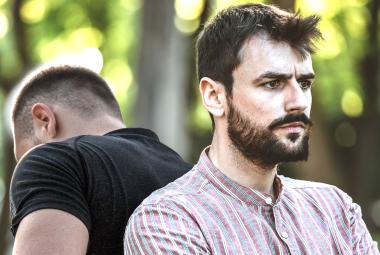One professional occupation requires the skills discussed in two of my recent articles in this publication. In the May article, I described “conversation” as often being either a “dialogue or a monologue with interruptions.” The June submission identified and illustrated a method for questioning based on cross-examination from the courtroom. The teaching profession requires skill and utilization in both conversation and questioning as the practitioner develops any lesson plan or teaching strategy.
Classroom teachers have several modalities from which to design a lesson. You, O gracious reader, will quickly identify with two of the most common styles which we have all experienced during our formal educations. The first – typically called lecture – is a teacher-dominated monologue where the expert with skill and story explains to the student the why, what and how of some topic. Questions posed during the lecture often present themselves as little more than a tap on the “pause button” before the lecturer continues with his prepared notes and illustrations. Many teachers avoid this “monologue with interruptions” and embrace the principles of the Socratic Method. Named for Socrates, this method is a form of inquiry and debate investigating opposing viewpoints. It relies on questions and answers (or objections and responses) to stimulate critical thinking and to develop fundamental ideas. From a class to a coffee klatch, this application of the Socratic Method will look far more like a dialogue than a lecture. And it approaches the ambition of the dialectic method. Hmmm... dialogue and dialectic. Similar words whose basic meaning is clear from its components. “Dia-“ means two; “Logue” (or logos) means word; From “lect” we get words like lecture and lectern and lectionary. At the roots of these two words is the idea of two words, two opinions, two viewpoints or two expressions.
Which style of classroom teaching did you prefer – the teacher lecture or the classroom dialectic? The monologue or the dialogue? There is a wide range of preferences on learning as well as a wide range of professional opinions on teaching. Educational research has much to say about the benefits and limitations of various pedagogical strategies. If you want to search the internet for names like Pavlov, Piaget, Skinner, and Vygotsky (to name but a few) you will find all sorts of results and research on learning and teaching. That moves far from the theme this article addresses.
I have been asked by people over the years what it takes to be a teacher. From the home to the church to the tennis courts to the new coworker in need of training, people find themselves in a position to teach or to mentor. When faced with this responsibility, the reluctant recruit will often doubt both preparation and qualification. I offer for your consideration the following three-point standard to address the question of teacher qualifications:
- You have to believe you have something worth saying; and
- You have to actually have something worth saying; and
- You have to be willing to say it.
Before going on, re-read that list and see if your initial reaction is one of agreement or skepticism. I am a professional teacher with two degrees and three decades of public high school teaching experience. I have diplomas and certificates, and I am licensed to teach throughout the United States. With so many opportunities to be the teacher outside of a public classroom where no license or certificate is required, how can we know who is qualified? Let’s look again at each of the three stems of the standard above.
If you lack conviction that you have anything worthwhile to contribute, you will be frustrated from the outset at your attempts to teach. This is axiomatic, and I will resist rattling on about it. I do want to say that everybody has something to contribute – an experience, an anecdote, a question, or a proposition. As we embrace questioning and conversation, the role of the inquisitive mind is equal in value to the role of the informed mind. I have a saying that applies to my secular and sacred interactions and congregations. “Be blessed and be a blessing.” Pretty simple, huh? Come to every event expecting to have something to give and expecting to receive something as well. Know-it-alls beware! Feelings-of- inadequacy begone! We make room in conversation for everybody to contribute and everybody to learn.
It takes more than merely sincere intention to add something – you must have something to add. When I prepare a recipe, and the bag of flour on the counter has no flour in it, the baking is a fail, right? It is not enough to believe that I have the flour to make dessert – I have to have the necessary flour to make the dessert. Before this sounds like an unfortunate hierarchy of participation, the quarter teaspoon of baking powder is a small and necessary ingredient for the outcome to be the best it can be! In my classroom, as well as my conversation, I try to find a spot for everybody that wants to contribute. This leads to my susceptibility to what I refer to as “bunny trails,” and my students knew that if they could get Mr. Corlett talking on a tangent, they could avoid that lesson’s homework assignment! Scoundrels! I admit I was a willing victim to their tactics! From singing to field trips to determining the meaning of life, the possible “contributions” made by the inquisitive were unpredictable as well as rewarding. How many conversations have you been in recently where everybody contributed?
Which brings us to the third stem of the proffered teaching standard – each participant must be willing to contribute! This is no small issue. Where knowledge is power, education is empowering. Some people are unwilling to inform others, knowing they may propel them to greater accomplishments. As a teacher and as a coach, the greatest compliment to my efforts occurred when the academic or the athlete accomplished more than I ever did or would. Not everybody feels this way. This sense of competition has on the other end of the spectrum a fear of inadequacy. Frankly, some of this is being broken down in today’s social media where the audience is made up mostly of “friends” and where the affirmation from a “thumbs up” icon can lift the spirit of the poster for the rest of the week! In 2006, TIME Magazine named everybody who posted on the Internet “Person of the Year,” which means pretty much we were all honored! A decade later, there is increasing censorship and policing of public conversations on social media and the whole experiencing – despite being called “social” – is isolating and silencing. (I think that might be another article for another issue.)
The end objective of any teaching, training, mentoring, coaching and schooling is to change behavior. Whether that behavior is in the answering of questions on a test; whether that behavior is being a confident, competent, contributing citizen with a lifetime thirst for learning; whether that behavior is hitting a winning backhand down the line in tennis; whether that behavior is using on-line resources effectively to research a pressing topic; or whether that behavior is engaging effectively and respectfully in a dialogue – the end goal of teaching as to change behavior. For this reason, teaching through experiences like projects or hiking or reading are very effective in both learning and retaining what was learned. And where teaching depends on words, conversation and questioning are effective strategies for progress. Remember our example in Luke 24 (see the May 2019 issue) with the two disciples and Jesus on the road to Emmaus? Do you recall the lessons learned and the principles demonstrated? For extra credit reading, read John 8 (Jesus) or Acts 2 (Peter) or Acts 7 (Stephen) and do so with an eye to lessons you can learn about difficult conversations. Whether we are addressing issues pious, personal, philosophical, political, or problematic, we can all contribute when we have something to offer and are willing to do so. Isaiah wrote, “Come now and let us reason together, though your sins be as scarlet they shall be as white as snow.” Let’s have that conversation!





